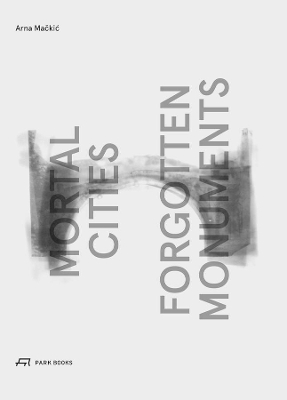Mortal Cities & Forgotten Monuments
In her book Mortal Cities and Forgotten Monuments, Arna Mackic explores the topic of war damage to cities and the destruction of their inhabitants' built environment. Mackic, who as a child together with her family had to flee her native Bosnia during the civil war of the 1990s, in her research follows the question "How does destruction make one feel?" The aggressors in the Bosnian war meticulously planned which buildings to destroy to maximise psychological impact on a city's inhabitants. Arguably the most famous example is the bridge of Mostar. When its architecture is destroyed, the face of a city changes, sometimes beyond recognition. Mackic also investigated the role that architecture played at turning points in the history of former Yugoslavia, in particular that of the monuments built between the late 1940s and the 1960 commemorating the victims of fascism under German occupation during World War II. The new book also features Mackic's her proposal for restoring cultural memory through architecture, applying a new open design language that goes beyond political, religious, or cultural interpretations. It outlines options for design interventions in urban space, rooted in ancient traditions while constructively aiming at the future. In her book Mortal Cities and Forgotten Monuments, Arna Mackic explores the topic of war damage to cities and the destruction of their inhabitants' built environment. Mackic, who as a child together with her family had to flee her native Bosnia during the civil war of the 1990s, in her research follows the question "How does destruction make one feel?" The aggressors in the Bosnian war meticulously planned which buildings to destroy to maximise psychological impact on a city's inhabitants. Arguably the most famous example is the bridge of Mostar. When its architecture is destroyed, the face of a city changes, sometimes beyond recognition. Mackic also investigated the role that architecture played at turning points in the history of former Yugoslavia, in particular that of the monuments built between the late 1940s and the 1960 commemorating the victims of fascism under German occupation during World War II. The new book also features Mackic's her proposal for restoring cultural memory through architecture, applying a new open design language that goes beyond political, religious, or cultural interpretations. It outlines options for design interventions in urban space, rooted in ancient traditions while constructively aiming at the future. AUTHOR: Arna Mackic, born 1988 in Capljina, Bosnia, graduated in 2010 from the Department of Architectural Design at the Gerrit Rietveld Academy in Amsterdam. She has been working with Rietveld Architecture-Art-Affordations RAAAF since 2009 as an architect, designer, researcher, and project leader. 31 colour, 123 b/w illustrations
-
Autore:
-
Editore:
-
Anno:2017
-
Rilegatura:Hardback
-
Pagine:160 p.
Le schede prodotto sono aggiornate in conformità al Regolamento UE 988/2023. Laddove ci fossero taluni dati non disponibili per ragioni indipendenti da Feltrinelli, vi informiamo che stiamo compiendo ogni ragionevole sforzo per inserirli. Vi invitiamo a controllare periodicamente il sito www.lafeltrinelli.it per eventuali novità e aggiornamenti.
Per le vendite di prodotti da terze parti, ciascun venditore si assume la piena e diretta responsabilità per la commercializzazione del prodotto e per la sua conformità al Regolamento UE 988/2023, nonché alle normative nazionali ed europee vigenti.
Per informazioni sulla sicurezza dei prodotti, contattare productsafety@feltrinelli.it



